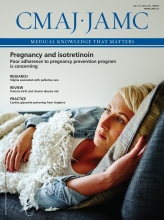A 69-year-old man with a history of severe nonischemic cardiomyopathy managed with a cardiac resynchronization-defibrillator presented to the outpatient clinic with uncomfortable pulsation over the left upper-abdominal area when lying on his left side. He was hemodynamically stable. When he was recumbent in a left-lateral position, there were visible and palpable contractions of the left upper-abdominal wall musculature (Figure 1; Appendix 1, available at www.cmaj.ca/lookup/suppl/doi:10.1503/cmaj.150986/-/DC1).
A 69-year-old man, with a history of severe nonischemic cardiomyopathy managed with a cardiac synchronization-defibrillator, lying in a left-lateral position with contractions of the left upper-abdominal wall musculature.
We suspected diaphragmatic contraction caused by inadvertent phrenic nerve stimulation by the left ventricular lead. We confirmed the diagnosis noninvasively by reducing the left ventricular pacing amplitude of the lead.1
Phrenic nerve stimulation has been described in up to one-third of patients with traditional cardiac resynchronization-defibrillator devices because of the proximity of the phrenic nerve to the pericardial veins, which makes the nerve susceptible to stimulation by the high-amplitude left ventricular lead.2 This problem has become much less common with the recent development of quadripolar lead technology.3
Phrenic nerve stimulation can be continuous or paroxysmal and can cause dyspnea, uncomfortable muscle twitching, hiccups and general malaise.2 It can be challenging to diagnose for those not familiar with cardiac resynchronization-defibrillator technology.4
Phrenic nerve stimulation is highly posture-dependent. It occurs more often when the patient is in a left-lateral position rather than in a supine position.2 Although phrenic nerve stimulation is not life-threatening, it can cause substantial discomfort to the patient.2 The problem can almost always be mitigated noninvasively with electrical reprogramming of the cardiac resynchronization-defibrillator.5
Please see the following video online: A patient with phrenic nerve stimulation caused by a cardiac resynchronization-defibrillator. www.cmaj.ca/lookup/suppl/doi:10.1503/cmaj.150986/-/DC1
Footnotes
Competing interests: None declared.
This article has been peer reviewed.
The authors have obtained patient consent.












